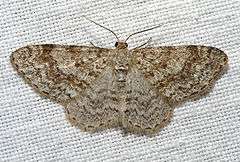Larentiinae
| Larentiinae | |
|---|---|
 | |
| Waved carpet (Hydrelia sylvata: Asthenini) | |
| Scientific classification | |
| Kingdom: | Animalia |
| Phylum: | Arthropoda |
| Class: | Insecta |
| Order: | Lepidoptera |
| Superfamily: | Geometroidea |
| Family: | Geometridae (but see text) |
| Subfamily: | Larentiinae Duponchel, 1845 |
| Tribes | |
|
Asthenini | |
| Synonyms | |
|
Larentites Duponchel, 1845[1] | |
Larentiinae moths contain roughly 5,800 species[2] and occur mostly in the temperate regions of the world. They are generally considered a subfamily of the geometer moth family (Geometridae) and divided into a few large or good-sized tribes, and numerous very small or even monotypic ones which might not always be valid. Well-known members are the "pug moths" of the Eupitheciini and the "carpets", mainly of the Cidariini and Xanthorhoini.
Systematics and description
Morphological and DNA sequence data indicate that they are a very ancient lineage of geometer moths; they might even be distinct enough to warrant elevation to full family status in the superfamily Geometroidea. They share numerous plesiomorphic traits – for example at least one areola in the forewing, a hammer-shaped ansa of the tympanal organ and the lack of a gnathos – with the Sterrhinae which are either somewhat less distant from other geometer moths or are part of the same distinct lineage; the Lythriini were until recently placed in the Larentiinae but are apparently Sterrhinae.[3]
But the Larentiinae characteristically tend to have much longer foreleg tarsi and hindleg tibiae than their relatives, and also have hairy or toothed extensions on the upperside sections of the transtilla; their caterpillars often have the abdominal prolegs reduced already (as is typical for the more advanced geometer moths), and the Larentiinae's tympanal organs have a unique and characteristic structure.[3]
Selected genera and species
Erateinini
|
|
Genera incertae sedis
Several genera have hitherto not been definitely assigned to a tribe.[4] These include:
|
|
Footnotes
References
| Wikimedia Commons has media related to Larentiinae. |
- Forum Herbulot (2008): Family group names in Geometridae. Retrieved 2008-JUL-22.
- Õunap, E., Viidalepp, J. & Saarma, U. (2008): Systematic position of Lythriini revised: transferred from Larentiinae to Sterrhinae (Lepidoptera, Geometridae). Zool. Scripta 37(4): 405–413. doi:10.1111/j.1463-6409.2008.00327.x (HTML abstract)
- Savela, Markku (2008): Markku Savela's Lepidoptera and some other life forms: Larentiinae. Version of 2008-AUG-18. Retrieved 2009-APR-11.
- Young, Catherine J. (2008): Characterisation of the Australian Nacophorini using adult morphology, and phylogeny of the Geometridae based on morphological characters. Zootaxa 1736: 1-141. PDF abstract and excerpt